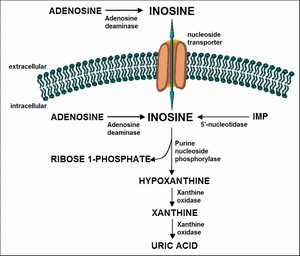Inosine

- INO-2002 (formerly IMS)
Inosine, the primary metabolite of the purine adenosine, is an important intracellular molecule of low molecular weight that participates in a wide variety of biochemical processes and serves as an extracellular signaling molecule. Although inosine is constitutively present at low levels in the extracellular space, metabolically stressful conditions, such as those that occur during injury, ischemia, and inflammation dramatically increase its extracellular concentrations. In contrast to adenosine, few physiological roles have been ascribed to inosine, which was generally believed to lack physiological actions and to serve as an inactive breakdown product of adenosine. Only recently has it been recognized that inosine can also bind to adenosine receptors and initiate intracellular signaling events, and Inotek’s investigators have played a pioneering role in this research. In addition, inosine can also affect cell function via receptor-independent pathways. Some of the modulatory actions of extracellular adenosine are mediated by inosine following a process that involves the uptake of adenosine into the cell and its conversion to inosine.
Inosine is formed both intracellularly and extracellularly. The deamination of adenosine to inosine occurs mainly at high intracellular adenosine concentrations that are associated with hypoxia, ischemia, and other forms of cellular stress. Once inosine reaches high concentrations inside the cell, it is shunted into the extracellular space via the operation of bidirectional equilibrative nucleoside transporters. Consistent with the fact that inosine exerts its most powerful regulatory actions on the immune system, adenosine deaminase expression is highest in lymphoid tissues. Similar to inosine, adenosine is liberated from cells during metabolic stress via nucleoside transporters. The catabolic degradation of inosine to uric acid takes place inside cells. Extracellular inosine and adenosine gain access to the intracellular space through both equilibrative and concentrative nucleoside transporters and adenosine and inosine can compete for these transporters. Thus, extracellular inosine can augment extracellular adenosine levels by preventing adenosine uptake and thus generate indirect biological effects secondary to adenosine binding to its receptors.